I was intrigued by the cover that referred to the escape of Mussolini. Francis Deakin in ‘The Brutal Friendship,’ a study of the relationship of Mussolini and Hitler, made him seem, in part, an Italian patriot. What would Eco make of him, I wondered. The blurb emphasised the thriller of Mussolini’s escape.
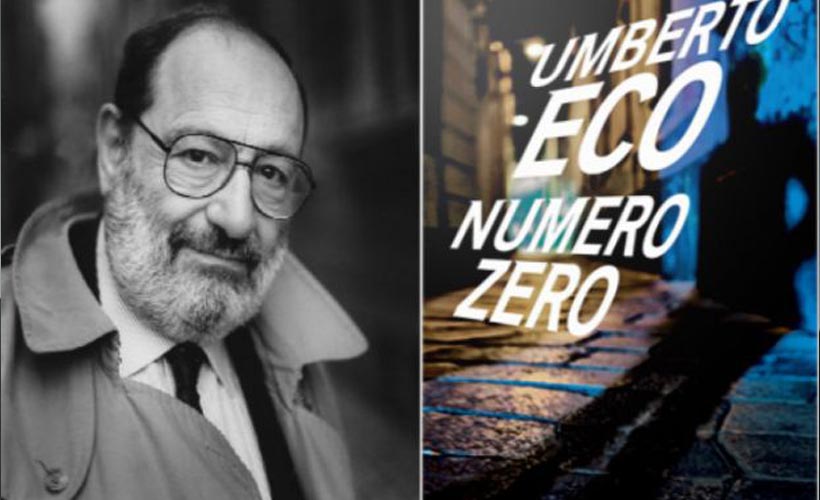
But….it takes forever to get to Mussolini, a quarter to the book or more, and then that part disappears.
This is the conceit. A nameless millionaire wants to start a newspaper. He hires a team of surplus journalists to do a proof of concept. They are to prepare dummy, uncirculated editions for a year. These specimens will be used to solicit other investors. Who knows, maybe that is the usual practice. None of the team, all writers and editors, know anything about the business side of publishing.
But some of the team are cynical enough to suppose that the dirt they put into the dummy editions might be used for blackmail.
There follows page after page about the media, its evils and manipulation. This lecture is relieved only by a travelogue through the streets of Milan. Oh hum. Not what it says on the back cover. Not why I bought it.
Then one of the journalists comes up with the story of a body double for Mussolini who was substituted for the real man. This is a discovery that is unrelated to the foregoing. It just pops out.
For this reader the book I bought starts there. Knowing nothing about these final days of the Fascist Regime, I found it a plausible speculation. The nub is this. While Mussolini’s face was known to millions through ubiquitous photographs, films, statues, postage stamps, coins, and more, few ever saw him up close in the flesh for more than a second or two apart from the inner circle.
Now add that he had a body double to foil assassinations and to do the boring duty of watching parades. This man might have a considerable resemblance and been at it so long that he came to think of himself as a Mussolini. He would be known to the inner circle.
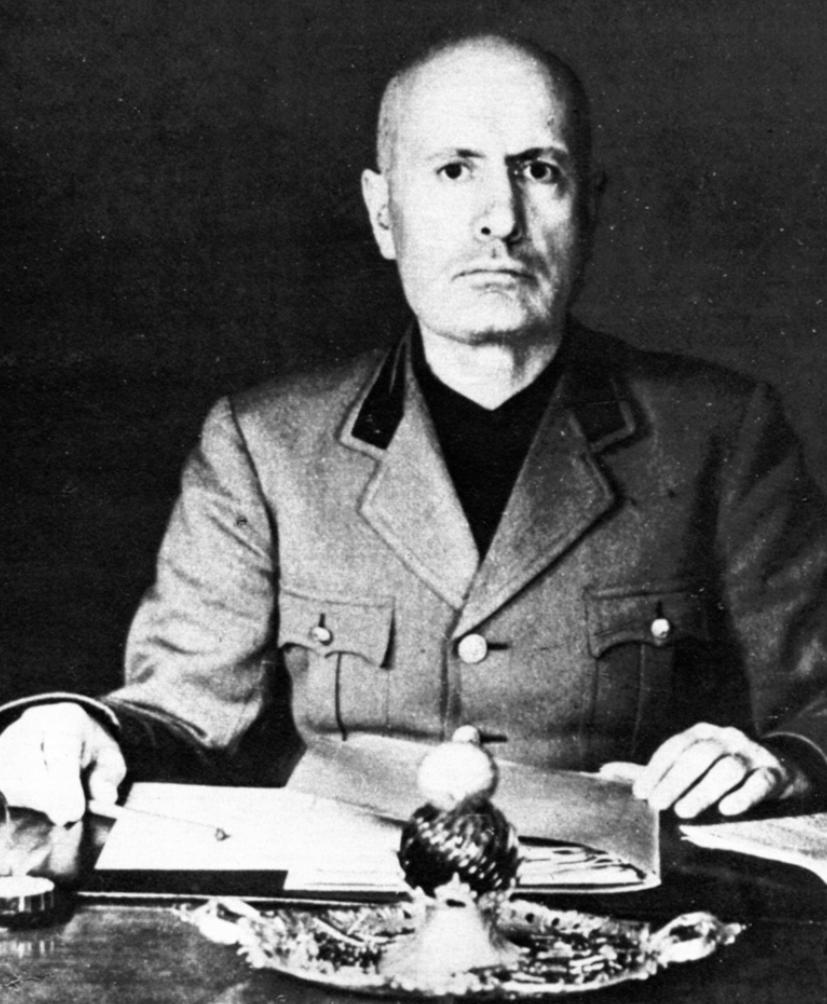
Add the wear and tear of the last months and years, weight loss, ulcers, narrow escapes, worry, stress and Mussolini’s physical appearance and mental balance would have been altered as well as that of his doppelgänger.
Finally much confusion as the last Fascists flee from the Italian partisans, hoping either to surrender to the Allies, but then they did not go south where the Allies were, or to make it north either to Switzerland or Germany.
Why escape? One, to save his life and perhaps to fight again another day. If Mussolini survived perhaps he could help others in the inner circle and their families. Perhaps a living Mussolini could negotiate for Italy. Perhaps a living Mussolini could be used against the prospect of a communist insurrection in Italy. Once the speculation starts, it has no end. All of this is interesting but there is very little of it, and it is only just that, speculation. None of it is fleshed out.
Much more interesting than another media diatribe or a streetscape of a corner of Milan. Though there are more lectures on the corruption of the media sprinkled throughout. Oh hum.
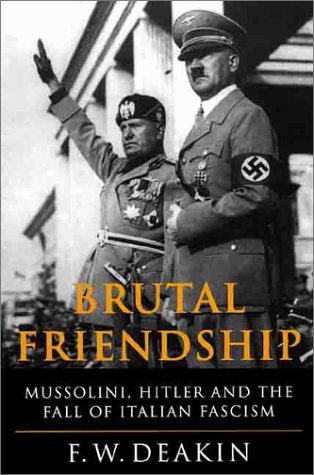
The Mussolini part disappears from the last third of the book in favour of more recitation of media evils and Italian corruption. Old news not particularly well told. Along the way are some obligatory sex scenes which the author is very poor at rendering. Must have been included to please an editor.
The Número Zero of the title has nothing to do with Mussolini, but is the first edition of the mock newspaper.
In sum: a major disappointment.
I once drove Signor Eco across the Harbour Bridge when he visited Sydney.
Category: Krimi
‘The High Mountains of Portugal’ (2013) by Yann Martel
Having been reading about Portugal, I tried this title.

It opens with a nice walk through 1903 Lisbon. I followed some of it on Google maps.
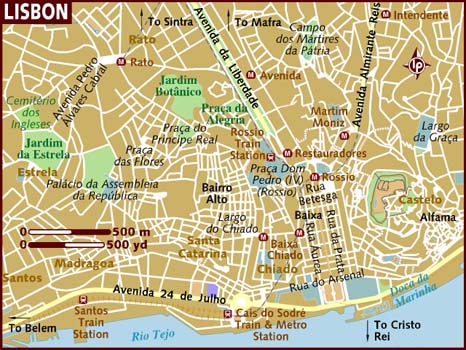
However this book is SO contrived. Our protagonist walks through the city backward, yes like a defensive safety or like Ginger Rodgers! He is sad and in mourning and expresses it in this way and has been doing this for a year or more. Oh hum. Thus making others responsible for not colliding with him. How egotistical. Out of my way! Coming through, backward! Yes I know walking backward can be a form of contrition but there is none of the spiritual depth of that implied in these pages, where it reads like what it is, a gimmick.
The backward walker reaches his rich uncle’s house and uncle is a lively character who wants to move with the times, in particular with the automobile. Many pages are consumed as the uncle tries to explain to the protagonist how to drive. He makes no effort to learn but some how does manage to do it. Backward, indeed.
He then drives off to the high mountains on a quest. To find an altar piece carved in Angola and which is in a little out-of-the-way church there. He read about the altar piece in a priest’s diary from the 16th century, which no one else has read, it having been buried in an uncatalogued box in the national archives, and then traced it through shipping, archival, and ecclesiastical records. That part was interesting but sped through.
Nothing compelling here. He manages to drive the car through villages to the amazement of locals and the boredom of this reader. It is a short book so I will flip more, but…
I did keep flipping. It is three stories connected only by the author’s assertion that they connect. After the motorist who does find the altar piece, which portrays Jesus on the cross as an ape. Better if it were an African slave after the harrowing descriptions of that.
Then a doctor and his wife in 1938 without any reference to the Salazar regime or the wider world that I noted in my FF, Fast Flipping.
Then in the 1980s a Canadian senator who retires there. Odd that. The author does seem to know anything about the Canadian Senate which is largely ceremonial. While the senator’s ancestors were Portuguese he hasn’t the language but moves there anyway in retirement with his recently acquired pet ape. Yep! The first scene of recognition with Odo, the ape, is very good, but then it is repeated with dogs, with birds, Odo can relate to anything.
Once again it seems to me that all this creativity is to impress other writers, awards panel members, and jaded reviewers and not to entertain, educate, or stimulate readers. Moreover, most of it seems to have been researched in manuals and reads like it, the car, the mountains, the apes; it reads like digests from Wikipedia interspersed with some dialogue and a few quite good scenes.
Even more depressing than reading the book is reading the high praise heaped on it by professional reviewers.
Morgue Drawer Four: Clink or Cooler? (2013) by Jutta Profijt
Pascha the unwanted ghost is still about, annoying the only human that he can contact, Dr Martin; the Goose, as Pascha calls him. Martin has taken extreme measures to control, if not rid himself, of this apparition by installing all manner of electronic gear in his home, offering feeble explanations to his long suffering girl friend about why he has an electronic net over the bed. Martin goes to endless lengths to conceal the fact that he is haunted by Pascha, though his one and only friend Gregor knows. Gregor is a man who can keep a secret.
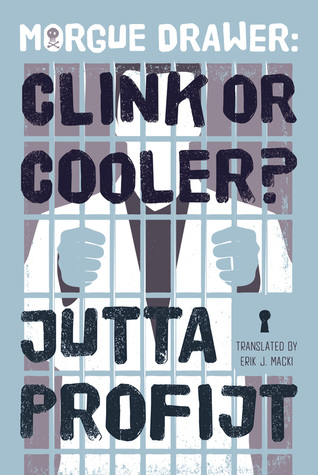
Gregor is Herr Detective Inspector Kreidler whom Pascha rather grudgingly admires. Gregor is an action man and that appeals to Pascha, the one time car thief.
But then then two police officers appear with a warrant and arrest Gregor, who lapses into an uncharacteristic passivity. Pascha is outraged and is determined to spring him.

He needs Martin for that but Martin is completely preoccupied with his girlfriend who is pregnant. Martin spends hours supervising her, arranging her diet, instructing her in exercises, telling her when and how to sleep, to rest by sitting such-and-such a posture. Martin is a health fanatic and this he imposes on her, well, he tries to do so but Brigit has a mind of own and the appetite of more than two. She may eat as he asserts when he is there but when he is not let the chocolate cookies, fruit bars, potato chips, anything and everything roll.
The only way Pascha can mobilize Martin is by claiming to be in contact with the soon to be born child. A lie but Pascha is a much-practised liar.
For her part Brigit is bored by Martin’s Regime and she wants to help Gregor, not sit quietly inn a dark room listening to soporific music eating lettuce leaves for six more months. (By the way, this sounds pretty much Martin’s idea of heaven.)

Martin, of course, does too but not at the expense of leaving Brigit’s side. He ends up towed along in her wake.
Loved the deal Brigit makes with the sleazy night club owner. How will she explain it later to Martin?

This title is fifth in the series. What a hoot they are. Keep it up Jutta!
‘A Climate of Fear’ (2016) by Fred Vargas
This is the ninth title in the tales of Commissar Adamsberg, the vague, unkempt, inquisitive detective, played in a film adaptation superbly by Juan Garcia.
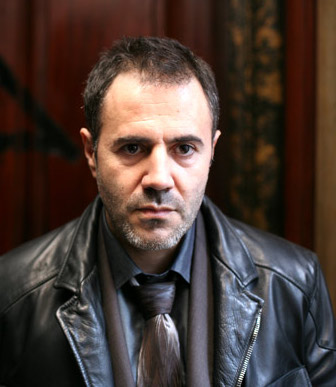 Juan Garcia as Adamsberg.
Juan Garcia as Adamsberg.
There are also television episodes that have all-star guests like Charlotte Rampling. In the following picture from the television production we have Adamsberg, Danglard, and Retancourt.

The characters are varied and amusing; the dialogue is human and humane; the situations stretch from the mundane to …. Iceland and back.
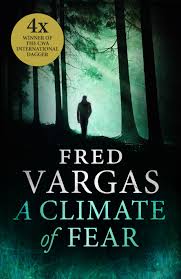
How does she do it, Fred Vargas, one time professor, now full time writer? Well, I hope she is at it full time because it is a big world and more of it needs Adamsberg, Danglard, and company to resolve its mysteries.
The setup in this title? An elderly woman is found dead in her bath with slashed wrists. She had terminal cancer and the gendarmes call it suicide, and following procedure they photograph the scene and present it to the station chief to sign off and close the file. Bored, he reads the file and looks at the pictures.
Odd that symbol drawn in lipstick on the side of basin.
He calls Danglard, Adamsberg’s number two, famed in the small world of plod for his vast knowledge, retentive memory, and capacity to solve puzzles. Danglard has to see it for himself in situ, and being bored, Adamsberg rides along with Danglard for an outing. The symbol baffles even Danglard and once baffled he cannot quit. Adamsberg is indifferent as they return to their desks.
Then, by chance, a woman comes to the front counter of the nick to make report, but she finds the cop shop all rather distressing and turns to leave, her mission unspoken, but Danglard passes through the lobby and he, of unfailing courtesy, addresses her with great civility. She responds to his politesse, and in short order she reports…. It ties in with the ostensible suicide.
Now Adamsberg reads the file and the plot thickens. Terminally ill or not, why would such a formidable woman lay down fully clothed, hair done, perfumed, nails polished in the tub full of water and cut her wrists? Why would a woman described as determined and self-sufficient, give way? Why is there no suicide note? Why did she struggle in her Zimmer Frame to mail a letter that afternoon?
It all does not add up to zero. There is something more to do it and it meets the eye in the symbol that even Danglard cannot decode.
As ever there are tensions among the officers, numbering about twenty, in this unit. Adamsberg’s loyal number two is Danglard, and there are others who also suspend disbelief in order to be loyal to him, too. It takes suspension because he does go off on tangents, and some do not work, but others do. The tangents come from his intuition which he seldom can explain. Adamsberg is not articulate or learned.
Against this are the positivists in the squad who want facts, finger prints, DNA samples, eye-witnesses before making a move. The metaphysical cloud shovelers who follow Adamsberg are tested in this title, and even Danglard wavers. That phrase ‘cloud shovelers’ was hung on Adamsberg and his deputy in Quebec in an earlier title, but it sticks.
Characterisations are one of Vargas’s strong points. She differentiates her characters and gives them each space, in the way Frank Capra gave character actors camera time, believing it enriches the story, rather than detracting from the protagonist. It sure does. (There days most of the diminishing breed of character actors could be, and sometimes are, replaced by CGI. [Computer Generated Images, Mortimer!])
In this tale there is a thuggish stable man with a police record, who dotes on his horses while imposing discipline on them with whistles and words of kindness that abash both Danglard and Adamsberg. There is a retired nurse who dithers, but is incisive when it counts. There is a spoiled and petulant young man of twenty who has depths none anticipated. Then there are the history re-enactors, some of whom are even odder than Adamsberg.
Most of all there are the regulars, starting with Adamsberg wearing clothes that looked slept-in and probably were, again. Danglard who will never be promoted because he is an alcoholic, a single parent with a brood that takes up a lot of time and energy, and a walking encyclopaedia as far as colleagues can tell. There are many others on the team, like the Amazon Retancourt, who are all watched over the in the office from atop the photocopier by Snowball who figured decisively in one of the earlier tales.
In this title the plot is, as always, complicated, convoluted, and obscure. Yet when it is nailed, it all hangs together. Of course, it is far fetched and some of the touches of the bizarre are, well, bizarre, and probably unnecessary but they have become the decoration on Vargas stories. The bizarre touches, the boar, the mysterious island, are well judged, if distractions.
 Fred Vargas
Fred Vargas
Frédérique Audoin-Rouzeau (1957-), archaeologist by day and krimiest by night. At the Centre National de la Recherche Scientifique and then the Institut Pasteur she specialises in epidemiology, particularly the Black Death in Europe. Her authoritative study is ‘Les chemins de la peste’ (2003). Some dinner table conversation there I expect.
‘An Invasive Species’ (2015) by J. J. Salkeld
A new locale, a new investigator, a new approach for this jaded reader of police procedurals.
The protagonist, Owen Irvine, was once in policing and then spent a decade investigating social benefits fraud for the local council in Cumbria.

His past in policing is murky, and no doubt more of his backstory will emerge. Ho, hum. Backstories do not a front story make.

Tracing penny-ante fraudsters is not much fun for Owen but there are challenges. Mostly though his prey are single mothers trying to squeeze a few more quid from the system for their kiddies, or so they say despite the new car in front, the satellite dish on the roof, and the ashtray full of St Tropez cigarette stubs on the table.
Owen is numb, having heard all the lamebrain excuses before, each told as if unique.
Not only does the council squeeze the pounds it pays to claimants, it also squeezes those it pays to the investigators, and the chopping block has Owen’s name on it. While his record is the best, it is too good, because he has banged up more than one relative of a councillor. In this and several other ways, the plot is leaden.
Then he meets one fraudulent claimant who is different. It is another woman, but one without excuses to offer, who seems educated, and smart, and who admits her crime, and yet …. she was desperate enough to pull a stupid stroke for a few hundred quid.
Owen breaks his own rule and asks why? He has never had to ask before. Always before he is told an avalanche of reasons he does not want to hear, because he is only serving the injunction, not making the decision. This one, Clare, tells him reluctantly a story about a man who deceived her, took advantage of her, and drained her bank account.
He passes the story onto a comrade in arms at his old nick, and, by the legerdemain of crime fiction another similar case arises, and the chase is on. Well sort of.
There a reality check in this book. Time is budgeted and for a crime without violence, for a crime where there is no evidence of a crime apart from the drained bank accounts, the time allocated is half a day. Imagine what a Star Trek film would be like if there were a Star Fleet budget. No more warp engines, Captain, we are out of dilithium crystals and do not have the gold-pressed latinum to pay for more until the end of the space-year.
Ah but the recently sacked Owen, who is more or less financially independent (because he owns his home, has a vegetable patch, a trout stream, an eternal Land Rover, and few needs), has plenty of experience in finding people who do not want to be found and time on his hands.
That is the set up. A pretty good one, if only it had been told with some élan or wit.
This reader felt the boxes being ticked. Perhaps that is inevitable in the first title of the series. Owen’s backstory is forced into the foreground. To do so makes it very wordy and slow. Though Owen is supposed to be laconic and reserved, but he talks about himself incessantly to get that backstory out. To enhance Owen he is made a victim in the dismissal by the council and by implication in his earlier dismissal from the plod. A poor put-upon hero, yet again, martyr to his virtue. All of this background interferes with any interest in the foreground. The time and place are described but they take a distant second place, and that is a shame, because the regional setting is what I found attractive at the outset.
Among the compensations are some lively scenes. The puzzling interview with Clare is one. Another is with a fraudster who seems to have done it just for fun and enjoys discussing it with Owen. Then there is the police officer who is uninterested in the information Owen passes on. They have a pissing contest, as they say on Channel 7Mate. Predictable but well done.
Regrettably, but perhaps inevitably in this kind of context, all the characters sound alike, use the same speech mannerisms, idioms, and vocabulary. All the police officers sound alike, even the educated Asian woman. Indeed, Clare is only distinctive voice in the early going, and that is a plot device, to be sure, and a good one, but it emphasises how monotonic the rest are, including Owen.
 J. J. Salkeld, a very industrious writer to judge from the array of titles on Amazon. Strength to his arm.
J. J. Salkeld, a very industrious writer to judge from the array of titles on Amazon. Strength to his arm.
It is the first in a lengthy series and perhaps things come together. Time will tell, if I get back to it. I found it easy to put aside.
‘Schrödinger’s Gat’ (2013) by Robert Kroese
A noir krimi with quantum physics!
I selected it for the Kindle because I smiled at the title on the cover. Wait! There is more. It is a krimi based on quantum physics. Yep! (It also represented light relief from reading Nietzsche.)

Huh?
That is how our protagonist reacts. ‘Huh?’ He is Paul, one very depressed loser in San Francisco whose path crosses that of Tali, who saves his life but she runs away when he tries to thank her.
A chartered loser, he is used to people avoiding him, but not quite like this. He pursues her, and, without breaking stride, she promises to explain all, but first he has to grasp some quantum physics.
Huh? Well, all right.
But before she can explain much, she first has to do a few things, and, well, seeing is believing, and Paul sees enough to … believe, a little. She arranges to met him for a further explanation but she is a no-show.
Huh? (Paul has a small vocabulary.)
What is a fellow to do but Google it; he reads up on quantum physics, advising readers in direct address to skip that part of the book. I should have, but I didn’t. Had I, that would have been in total about three-quarters of the book. Of course the cat comes up.

During this ersatz research he comes across the name of a Stanford scientist, the summaries of whose work on websites sound like Tali’s interrupted exposition. While the scientist seemed to have had a fine career strewn with publications and accolades until a few years ago when he, too, seems to have disappeared. Huh. (See!)
But even a loser can use the telephone book and Paul finds a street address that might be that of the professor. Hey, presto!
Well, that’s a lead. What would Philip Marlow do? Doh! He would go see the professor.
It is a mile-a-minute, except for the asides on matters quantum physics, and is it droll. dry as dust. Regrettably the asides on QP increase, and go on and on. The mile-a-minute stretch like a Salvador Dali watch.
Oh, and the cat. Did I mention the cat? Well, there is neither a cat nor a gat. Which word I always assumed was derived from Gattling gun, the rapid fire weapon developed in the Nineteenth Century, precursor to the machine gun. Another weapon so deadly that its inventor thought it would end war.
The set-up sounds better than it reads. It takes a quarter of the book to get the characters lined up around all the lectures on QP. There is so much preliminary fussing that it reminded of those dreadful Sunday lunches where the fussing over nothing is continuous so that the food does not appear until 4 pm by which everyone has had too much alcohol and a headache either from the drink or lack of food.
Then Paul inadvertently, if you can believe it, drops a homemade bomb into the fountain at a shopping mall and it kills a great many people. The cops arrest him and in his cell he reads Kant on metaphysics and shares it with the reader. Which is harder to swallow the bomb at the mall or Kant in the clangour? What is worse is reading it.
By this stage three-quarters of book has elapsed without any further sighting of Tali, and no explanation of events that this reader can follow. Where is that damn gat? Where is Schrödinger? Or even the cat?

Eventually this mass murderer is sprung on bail. What! Fire that DA and get one keeps capital criminals in the slammer.
There is a final confrontation of sorts but mostly it is like one of those post-modern conference presentations where the words flow but the meaning does not. The characters talk each other to death, or something. Hard to tell through my glazed eyes. Since this is San Francisco there is an ever handy earthquake to settle matters.
There is a long afterword with more QP. Enough, already!
 Robert Kroese, who has many other titles on Amazon.
Robert Kroese, who has many other titles on Amazon.
Following the afterword is a biography in which we read that the author wrote his first novel in second grade. Is this it?
I did make it to the end, but only with quick thumb work flipping the pages with very little reading and less pleasure.
‘A Small Death in Lisbon’ (2002) by Robert Wilson
I break my rule and write about a book I disliked, doing so in part to crystallise what it is that I did not like about, and why I tried so hard to read it.
I tried to read this book years ago, and was recently moved to try again since my interest in Portugal was kindled again a few months ago by reading about the Carnation Revolution of 1974 but my efforts to find Portuguese novels that I might like have failed.
Yes, I have read some by that Nobel Prize winner, José Saramago, but found them desiccated, didactic, and dull. In short, lifeless. They told me nothing about Portugal or any Portuguese.
Reviews of lists of Portuguese novels on websites did not help either where even the krimis were described by the deadly term ‘surreal’ that is code for incomprehensible and self-indulgent which some mistake for creativity. On such lists I found ‘Ballad of Dog’s Beach’ by José Cardoso Pires which I read and reviewed elsewhere on this blog. It did not inspire me to choose another title from such lists. As an indicator of nonsense the term ‘surreal’ is as reliable as the label ‘post-modern.’
Robert Wilson is routinely accorded the accolade of a best selling author on the covers of his many novels from major publishers. All hail. The reviews in credible sources are respectful, if not enthusiastic. Knowing that I know nothing, I tried again.
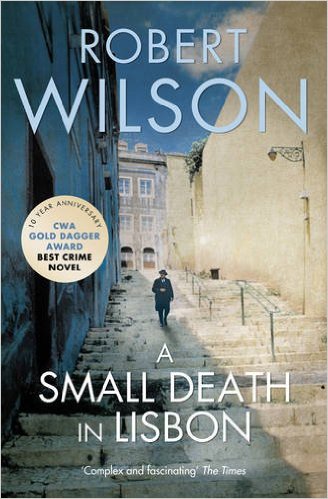
It has a split story line, then and now with some in-between, and the reader, I guess, is supposed to be puzzled about how they come together. Me, I just assumed some hocus-pocus would bring them together. I cannot abide this approach to story-telling because it puts responsibility on the reader to make sense of what is written. This joke is not for this folk.
The respectful reviewers say it offers a travelogue of Lisbon and that is what enticed me to read the book both times. So on I went, screen-by-screen on the Kindle. My dentist does not approve, all that gnashing, grittimg, and grinding of my teeth which will undo his good work. With the iron discipline for which I am famed, I quit — again — at 61%, according to the Kindle.
Here is what I found as I made my way to that 61%.
We have Klaus Felsen a German businessman forced to go to Portugal in 1941 to buy rare industrial metals for the Nazi regime and to try to prevent the British from getting them, too. It seems he is the only man for the job since he speaks Portuguese, learned from a few weeks with a Brazilian woman. Ah huh. Fluent no doubt. It is February 1941, and there is one reference to the Eastern Front, though there was not one until 22 June 1941. The hindsight is all to evident throughout.
Sometime in the 1990s we have world weary inspector Zé Coelho, who mouths gratuitous criticisms of the society he serves, and despises those who cooperated with the late and unlamented Salazar regime, a group that would have included most of the country. He wears his alienation on his sleeve. Everyone he meets is awful. Especially those with money. So it goes. When figures in police procedurals engage in this kind of cheap cynicism, my supposition is that the reader is to take it as social criticism. Ever the rebel, I take is as cheap cynicism.
There is a lot of coming and going in Lisbon of the 1990s, and I liked that. I used a Google map to follow some of it on the iPad. That kept me going as long as I did.



The book also features much sex. Both of the protagonists, Felsen and Coelho, are irresistible to every woman they pass. There is enough detail to satisfy a gynaecologist.
Felsen, the good German, also goes in for murder and torture, and these deeds are also lovingly described from anatomy textbooks: wires to the genitals of the helpless victim. No electricity, just wires. The thugs, these he kills with rocks.
Time passes in the back story from 1941 and Felsen remained in Portugal when the war ended. He gets even with all his enemies, in part, because of the love of Eva. Who? [Sound of violins over the screams of his victims,]
The Portuguese peasants Felsen enslaves to his smuggling operation are described in bestial terms that must give some armchair readers a frisson. Me, I thought how simple-minded such characterisation is. For a dose of reality read the nature poems of John Clare (1793–1864) a day-labouring peasant just like those in this story. If people do not live in cities and read books, they cannot be as fully human as … the author, the reader, the editor. Thugs live and work on Bond Street, too, and even in some universities, I am told.
The preoccupations with sex and money can be readily interpreted in two ways. The first is ‘give them what they want.’ If it sells, write it. Here we may see the hand of the publisher pushing the author along. The other is the projection of the author’s own fantasies onto his characters. Pick one.
There are no compensations in the prose. Much of it is workmanlike and gets us from A to A1. However, there is far too much that is overwritten. ‘Overwritten?’ one might ask. ‘What does that mean?’ Here are a few examples;
‘her knees looked tired’
‘an in articulate shriek’ from a closing door
‘an enclosed man’ who was waiting in the alley
his ‘breath was cigar streaked’
she rose on ‘strong legs’
the ‘walls drank in the evening light’
the school girls began an ‘elephantine dancing’
There are many, many more examples of this overwrought and meaningless prose. I just stopped highlighting them on the Kindle. Each time, this slow wit, had to read the sentence twice in the forlorn hope that there was a point to the prolix prose. Nope.

When I gave up I did take a look at the comments on GoodReads and was once again confirmed in the conclusion that it is pointless using that as a reference. The narcissism (look it up. Mortimer) of many comments allows me quickly to skip most entries, and the others read like support of relatives.
Nota Bene. We watched two episodes of the ‘Falcone’ krimi television series derived from another series by this same Robert Wilson set in Seville and found them gratuitously anatomical in the violence for no other reason than to get a restricted rating to make naive viewers think they were getting something hot. While we liked the travelogue of Seville, it was not enough to put up with the plucked eyeballs and roasted human flesh. The effort to shock is so adolescent.
I hesitated a long term before publishing this, but decided to get it out the door. Reading the imbecilic reviews on GoodReads stimulated me to add my two cents.
****
What I would like would be a krimi set in 1974 as the Carnation Revolution unfolded and in the heady-ing and confusing days that followed, catapulting Field Marshall Antonio de Spinola to the head of a committee of national salvation and driving the eternal Salazar regime into exile.
Perhaps such a book exists but I have not yet located it. The dictatorship in the person of President Marcello Caetano refused to abdicate to the upstart captains who led the uprising, and insisted on entrusting the government to a high ranking officer who, of course, had also to be acceptable to the upstarts. There was only one candidate, Spinola, whose public and private criticisms of the regime were known even if uttered sotto voce and published abroad. He did not want the job, the captains did not choose him, and Caetano did not want to concede, but the hour called the man.
Enter Spinola, pulled from one side and pushed from another. The captains wanted a quick result before their tissue thin conspiracy unravelled so they accepted Spinola as the only senior figure they could tolerate. He took on the thankless task as a last service to the country. No biography of him is available in English, or I would turn to that.
If a prospective writer wants the job, here are a few tips.
Make it linear. Have a protagonist who is not the centre of attention but a prism of others.
Also please emphasise Lisbon as a character in the story, not just a backdrop, its hills, it redolent history, the balcony flowers, the worn steps, its narrow streets, the ubiquitous churches, the funicular, the prayer apses on the twisted streets, the allure of the Azores, the stifling shroud of an ancient Catholicism, and the repression that hung over everything, the secret police, mysterious disappearances, political prisoners, the nearby Spanish border and the sclerosis-ridden dictator still crouched behind it, and the exiles in Brazil broadcasting back to Portugal.
Remember also that there were Portuguese military officers, serving and retired, in 1974 who had been volunteers in the Spanish Blue Division with the Nazis at Leningrad, including Spinola himself. Most of all, remember the three colonial wars Portugal was engaged in at the time in which Spinola alone had secured victories and made peace. Add the pirate attack by Portuguese exiles on the cruise liner the Santa Maria a few years earlier. In the larger environment there is the Cold War and the developing European Union. Rich pickings.
In the foreground perhaps the tension might spring from bringing together an odd couple, say an enemy of the regime with a defender, and each discovers something of value in the other. The stiff devout old guard police investigator who had done military service in Africa teamed with a youthful critic, maybe a journalist. The journalist discovers the police officer is serious and just what he seems to be, simple and honest, not a perverted pederast hypocrite. The officer discovers the journalist is a patriot who wants to elevate Portugal not a slavering communist set on destroying the country and raping nuns.
There are plenty of incidents to choose from, even before the radio music signalling the rebellion, and then later the military counter-coup, the subsequent communist effort to seize power as Lenin did in October 1917, the democratic descent into confusion. All this was in the cities, while in the countryside life continued to follow the rhythm of nature. Or did it? Maybe not on the Spanish border. Maybe not on secluded coastlines where small boats might land unobserved, perhaps from Brazil.
Add to this the reaction of Big Brother in Spain. Franco was still a factor, catatonic though he was.
I have watched some of ‘Capitães de Abril’ (2000) on You Tube without the benefit of English subtitles. Earnest, this I could see, but lacking in tension to this distant viewer.
Evariste Clovis Désiré Pel, biography
It is time that Chief Inspector Evariste Clovis Désiré Pel had a Wikipedia biography along with Jules Maigret, John Steed, James Bond, Lois Lane, and Xena.
He appeared full grown like Athena in 1979 (‘Death Set to Music’), Pel has had a long career in crime, crime-fighting, that is. the last outing was in 2002. His biographers have been John Harris, writing as Mark Hebden, succeeded by Juliet Hebden. Pel was a child during the German occupation, ten or less.
We shall start with that name. It is a cross to bear for Monsieur L’inspecteur Pel, who cringes whenever he is asked for his full name, say when renewing the driver’s license. In reply he hunches and mumbles to limit the number who hear. Three forenames is too many and none of them is particularly masculine, but the worst part is the third, Desired One — Désiré — a name usually reserved for girls.
His second most important characteristic is that he is in, for, and of Burgundy, and if possible never leaves it. Ever. Beyond Burgundy is, well, France (with the cesspit that is Paris) which is a foreign country to Pel, and beyond France lies darkness. In his moments of calm, few as they are, Pel savours Burgundy as Eden on earth. The trees, the patchwork fields, the stone farms houses, the blue tiles on roofs in the capital, the Palais de Ducs, the mellow yellow sun, the cuisine, the wine, all is perfection. He positively sings its praises, in his mind.
He is to the core a flic, and nothing but. ‘You’re nicked, you slag,’ snarled by Inspector Jack Regan would warm Pel’s heart. He would not understand the idiom but he would grasp the music of it immediately. Pel has risen through the ranks from the uniform service, where he stood in police lines while students from rich families threw rocks at him personally; and these students are now lawyers and doctors who fiddle their income tax, he is sure. Here is another Pel characteristic. He takes everything personally. From thence to Detective Sergeant, Inspector, and Chief Inspector. In the later role he has ten detectives to direct.
We meet Pel in his forties, he is short, slight, nearly bald with a few wisps of mousey hair, near-sighted with reading glasses pushed up on this head. Whatever clothing he dons at home, by time he arrives at the nick he looks like a hobo just off the rails. Even his best blue suit, the one he bought against the day, which day has not yet to come, when he receives a Légion d’Honneur from the President of France, becomes stained, creased, begrimed, and baggy as soon he takes it out of the dry cleaner’s paper. By the time he gets to the office, it looks like a sleeping bag gone wrong.
He is completely and totally addicted to Gauloise cigarettes, of which he smokes at least a pack of twenty a day, living in constant dread of running out, while promising that each one will be the last. Blind panic the strikes him when the prospect of running out arises.
Pel is an Olympic worrier. He mostly worries about his health. Those cigarettes! If he passes a person in the street who coughs, Pel is instantly paralysed with the fear that he is about to catch a mysterious mortal disease. Dr. Minit has long grown tired of his panics and laughs at him while offering a drink, thus confirming to Pel’s mind that he has little time left since the quacks never say if it is bad news.
If he is out of the office for long, he worries that the Police Judiciare will collapse without him, and so he is a frequent nocturnal visitor to the office. He is a lousy driver because he is always thinking about his cases or his health.
Despite squirrelling away in the bank nearly every franc that has come into his possession, he fears a life of penury, the more so when he retires on a police pension. This worry is despite the bank manager’s comment that Pel has a fortune in his account. He also fears he will be forced to retire all too soon since he is neither liked nor respected, and he does not understand the computer system that is coming online.
By some dark Faustian bargain, he has a live-in house keeper, one Madame Routy who exercises a domestic tyranny. In all of Burgundy she is the only person who cannot cook. She serves up sludge, called stew every night, which more often than not it is his only meal of the day. Worse, she watches television all day and all night with the volume at thunderous plus. Will his shabby house vibrate itself into destruction? He abides because he dares not rebuke her. She might quit and where else could he find a house keeper to live in his dilapidated house and work for the meagre pay he can offer. Moreover, her nephew Didier comes to visit sometimes and Pel likes Didier. When the boy grows up and enters the police service, Pel swells with pride before breaking into a sweat at the thought of all the dangers that will afflict Didier as a constable.
At the PJ he runs a tight ship. Few words of praise escape his lips. Requests for time off are met with ‘Non.’ He is bitterly jealous of his senior sergeant Darcy’s easy way with women, and positively livid that Darcy always appears to have just stepped out of fashion magazine, even when Darcy has been up all night on surveillance. So livid is Pel that to make himself feel better he searches for some fault to criticise in Darcy. He is even more angry because nothing he says phases Darcy who shrugs it off.
Pel loathes Sergeant Misset who combines being lazy with being stupid to a high order, but Pel can find no way to shed him from the squad where he spoils everything he touches. Pel bears a lifelong grudge against the traffic division which arranged for Misset to be transferred to his squad.
Then there is young Nosjean, the impoverished Baron de Troq, Lagé, the soon to retire Krauss, Claudie Darel whom he is sure will take his job away from him because she is terrifyingly smart, and then there is the Lion of Belfort who leaps into action at light speed: Annie Saxe, who is called La Lionne de Belfort for her mane of red hair and her origins in Belfort where there is gigantic statue in red sandstone of …. [Go on, guess.] Yes, a lion!)
Pel is a very effective officer, calm, decisive, and confident. In a crisis he knows what to do and how to do it. He rattles off brisk orders that give each officer a task and knits them together into a concerted action. While bemoaning his ill health, he works younger men and women into the ground.
Often he prefers to watch and wait, withstanding bureaucratic, political, and media pressure to act. His steely resolve in such circumstances inspires the members of his team, while he assumes they despise him.
He speaks a passable English. His father insisted that the children, Pel and his two older sisters, learn English on the assumption they would go into the wine business. Though he overflows with all the prejudiced stereotypes about the Les Rosbifs, he sits in a ‘comfort anglais,’ drinks scotch, and savours Yorkshire pudding on occasion. His one effort to prepare Yorkshire pudding bore a passing a resemblance to the Battle of Somme, such destruction did it leave in the kitchen for Madame Routy’s return!
His solitary life is lightened by the interest of the widow Madame Geneviève Faivre-Perret who seems to enjoy his company. Darcy was instrumental in their liaison and occasionally has been known to observe their affair with an bemused smile. While Pel is desperate for Madame, he is also terrified that he cannot afford to marry, to go out to dinner at a good restaurant, to buy a new car, to move house, and he cannot possibly change, much as he would like to do so. He worries himself sick about telling her his whole name!
He tries many things to please her, most of which backfire. He is as tongue-tied and confused as a teenage boy where she is concerned. All of this seems to amuse her still more. His daily resolve to quit smoking takes on an added urgency because he is sure she disapproves, and the fact that she has never said so, that being the final proof! His efforts to quit smoking are many and useless.
Pel has no interest beyond policing and so Darcy speculates on what Pel could find to talk about with Madame Faivre-Perret. By the way, Darcy lets Pel’s frequent bouts of bad temper slide off without reaction, which often infuriates Pel all the more. Pel is indeed irascible.
Pel sometimes dreams of being a Maigret, stolid, implacable, all-knowing, infinitely patient, imperturbable with a Madame Maigret to give him coffee on 3 a.m. call-outs and fill him with delectable home cooking. Ah… He entertains this fiction most often when swaddled in all the wool clothing he has, looking like the Michelin man, standing a midnight watch on a windswept hilltop in a January winter where the temperature is sub-zero and the gale is Siberian, or perhaps Arctic. Worse, the wind makes it impossible to smoke! Another of Darcy’s annoying characteristics is that he does seem to mind the weather — hot or cold, wet or dry — as he waits it out next to Pel.
‘Pel and the Predators’ (2008) by Mark Hebden
Back in Burgundy with the irascible Evariste Clovis Desirée Pel, Inspector, Police Judiciaire. There are a score of these titles. He is short, with a few of remaining strands of mousy hair stuck to his bald pate, like sparse seaweed on a rock at ebb tide, chronically addicted to smoking two packs of unfiltered Gauloises a day, morbidly afraid of penury, socially inept, near sighted, a hypochondriac, and bad tempered for these and many other reasons. He takes out his bile on criminals who upset the idyll of Burgundy, from which he never willingly departs.

A dead girl who washed up on the distant Breton shore seems to have come from god’s country, Burgundy, and Pel makes routine inquiries that soon prove to be anything but routine. He reluctantly leaves Burgundy to travel to Breton to be briefed. When there, he felt he was standing at the edge of the world. Beyond Breton, beyond France, there is only blackness. His interview with the local detective, Bihan, is priceless. This Bretonnais is an imaginative type who has speculative backstories for everything and this elaboration drives Pel to his cigarettes and beyond. Eventually the point is made.
Back in Burgundy two teenagers exploring each other and a cave find another unidentified body, long buried there, and Pel has to identify it, too. In time these two strands come together, as readers know they must. The two dead women have something in common, though not what one might think. No spoiler.
These titles are police procedurals and there is much plod, and Pel has a team of officers, now enlarged because he has been promoted to Chief Inspector, which elates him, briefly, before he starts thinking about the greater responsibility, and then realises the promotion does not carry a pay raise, then the gloom and doom takes over. Some of the officers are bright, others are hardworking, and a few are lazy and stupid, and Misset is both, but somehow Pel has to work with them all, despite his recurrent urge to hit detective Misset with anything to hand if only to see if he stirs when struck. Pel is sure that Claudie Darel will one day push him out of his job. She is so smart, and knows how to use computers! He has learned to listen to her interpretations of facts.
Pel is some character. Somehow he has entered into a Faustian bargain with Madame Routy as his housekeeper and cook. He does not remember hiring her but there she is and he cannot fire her, since she seems to come with the house. In Burgundy she is the only person who cannot cook. After serving up indigestible stews each night, she plonks on the sofa and watches television at full volume. Ever the worrier, Pel suppose the vibrations from the telly will destroy his house all too soon, leaving him homeless as well as destitute. Meanwhile, he is sure he has some wasting disease.
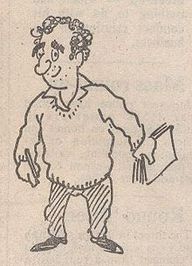 Mark Hebden
Mark Hebden
Into his miserable existence, lightened all too seldom by the chance to bang up a crime, comes the widowed Madame Faivre-Perret, a very successful businesswoman, who seems to have picked him for her next husband, or so Pel fervently hopes when not terrified by the changes marriage would bring to his (dis)ordered existence, and how much it will all cost! Pel is an Olympic worrier. But when he is with her, at lunch, in the cinema, strolling the avenue, he feels ten feet tall and light as air! He even manages not to smoke for periods of ten minutes or more, though she has never said anything, he is sure she disapproves. When he is with her he even smiles! A Pel smile is a rare thing, indeed.
The only other light in his life is the Madame Routy’s nephew, Didier, with whom Pel sneaks out of Madame Routy’s baleful sphere to have snacks at the bistro rather than eat her sludge. How Pel’s shrivelled little black heart sings when Didier, now a teenager, says he wants to be a policeman, and then Pel starts to worry about all the bad things that can and do happen to flics. Can that man worry!
‘Morgue Drawer for Rent’ (2012) by Jutta Profijt
This is the third instalment in this mile-a-minute series that combines science and ectoplasm. Herr Coroner Dr Martin Gänsewein remains saddled with Pascha, late car thief extraordinaire and murder victim. Of all the cadavers in all the pathology labs in all of the world Martin had the bad luck to slice into this one cadaver, complete with a ghost, who can communicate only with him, and who does, often.

They are the odd couple to end odd couples. Pascha, phantasm though he be, retains his lowlife interests and four-letter word vocabulary, while Martin is a round-shouldered, mumbling, introverted, shy, rumpled, near-sighted, hyper-conscientious scientist who eats lettuce leaves, flosses between his toes, and does not drink alcohol. ‘He calls that life,’ says Pascha with a snort.
In between solving crimes in the first two books, Martin spends much time, effort, and money in the vain attempt to screen out Pascha. Microwave transmissions disrupt Pascha’s atoms, he discovers, but harnessing those at home proves to be challenging and impossible at work. Having a ghost shouting in his mind has disrupted Martin’s slow and uncertain love-life with Birgit, and the fallout has confused his colleagues and friends. At times Martin oscillates between the hysterical and the comatose, caused as we and he know by Pascha’s hectoring.
Pascha can also interact with the voice recognition software of Martin’s computer which he uses to write an account of his adventures that he submits by email to a publisher, without Martin being the wiser. Pascha’s career as a writer is one theme in this romp. He is delighted to be published but angry that the work is called fiction!
Another theme is the new manager of the Forensic Institute of Cologne who is an MBA, charged to increase efficiency and cut costs to the bone. That he knows nothing of the legal environment in which the Institute works, that he cares nothing at all about pathology, that he knows nothing about preserving police evidence, these facts do not cause him to miss a beat. He simply delegates responsibilities to others while undercutting and undermining them. Ah, corporate life! The key performance indicators click over. At least he is no hypocrite, he does not mouth platitudes about the staff, he simply shafts them, belittles them, and shows open contempt for them. A refreshing honesty in that.
All of that is credible and the author must have worked in a large organisation where she observed this kind of McKinsey-speak management.
In no time at all the new boss, whom one of Martin’s colleagues nicknames Piggy Bank, is renting out the morgue’s facilities to funeral directors, who come and go at all hours of the day and night. Soon enough, things go missing, like the body of a murder victim. In the subsequent search for a scapegoat, Piggy Bank’s eyes land on the inoffensive, compliant, and meek Martin. He accepts his fate with resignation, while Pascha is outraged!
Meanwhile, Herr Piggy Bank is completely without scruple or shame. See, I said realistic.
Another of his innovations is to charge the police for consultations with the pathologists. In no time at all Martin has violated Piggy Bank’s many new rules and is dismissed. That frees him to probe more and he does but only because Pascha drives him to it.
Meanwhile, Pascha has stumbled onto the reason for the body snatching, and alerts Martin. It is more complicated than that, of course, because Pascha has fallen in love with Irina, a doctor, and Birgit has laid down the law to Martin about his strange lapses (when Pascha is yelling at him). On top of the that Cologne is hit by a relentless heatwave that makes everyone’s life a misery.
Pascha’s efforts to communicate his feeling to Irina are … extreme. The incorporeal and corporeal just do not mix. As always, his efforts backfire on Martin.
Piggy Bank is a marvellous character, the very model of modern major manager. He is tanned, even in winter we are sure, taut of skin, brisk of manner, clear of eye, devoid of conscience, free of knowledge, completely teflon, seen only when he wants something, totally indifferent to the staff who are only costs, obsequious to his superiors, haughty to underlings, tasseled of shoes, blazer-wearing, and he speaks but key performance indicators, single-mindedly pursuing his own advancement. Sound familiar?
It all comes together, and it all comes out in the wash. The plot is ingenious and kept me guessing until the author produced the rabbit. Then, ‘Voila!’ It all made sense. Several blue herrings added to the misdirection.
 Jutta Profijt
Jutta Profijt
Not all the loose ends were tied. When Martin, on Piggy Bank’s orders, refused to talk to police officer Jenny, she storms off to have it out with Piggy Bank, and….. I don’t know.
The self-deprecating joke the book ends with is delicious. Toilet brush indeed!
